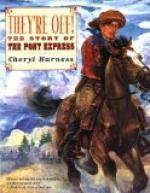The above are random extracts from frontier newspapers, printed while the Pony Express was running. The Express could never have existed on its high plane of efficiency, without an abundance of coolheaded, hardened men; men who knew not fear and who were expert — though sometimes in vain — in all the wonderful arts of self-preservation practiced on the old frontier. That these employees could have performed even the simplest of their duties, without stirring and almost incredible adventures, it is needless to assert.
The faithful relation of even a considerable number of the thrilling experiences to which the “Pony” men were subjected would discount fiction. Yet few of these adventures have been recorded. Today, after a lapse of over fifty years, nearly all of the heroes who achieved them have gone out on that last long journey from which no man returns. While history can pay the tribute of preserving some anecdotes of them and their collective achievements, it must be forever silent as to many of their personal acts of heroism.
While lasting praise is due the faithful station men who, in their isolation, so often bore the murderous attacks of Indians and bandits, it is, perhaps, to the riders that the seeker of romance is most likely to turn. It was the riders’ skill and fortitude that made the operation of the line possible. Both riders and hostlers shared the same privations, often being reduced to the necessity of eating wolf meat and drinking foul or brackish water.
While each rider was supposed to average seventy-five miles a trip, riding from three to seven horses, accidents were likely to occur, and it was not uncommon for a man to lose his way. Such delays meant serious trouble in keeping the schedule, keyed up, as it was, to the highest possible speed. It was confronting such emergencies, and in performing the duties of comrades who had been killed or disabled while awaiting their turns to ride, that the most exciting episodes took place.
Among the more famous riders[23] was Jim Moore who later became a ranchman in the South Platte Valley, Nebraska. Moore made his greatest ride on June 8, 1860. He happened to be at Midway Station, half way between the Missouri River and Denver, when the west-bound messenger arrived with important Government dispatches to California. Moore “took up the run,” riding continuously one hundred and forty miles to old Julesburg, the end of his division. Here he met the eastbound messenger, also with important missives, from the Coast to Washington. By all the rules of the game Moore should have rested a few hours at this point, but his successor, who would have picked up the pouch and started eastward, had been killed the day before. The mail must go, and the schedule must be sustained. Without asking any favors of the man who had just arrived from the West, Moore resumed the saddle, after a delay of only ten minutes, without even stopping to eat, and was soon pounding eastward on his return trip. He made it, too, in spite of lurking Indians, hunger and fatigue, covering the round trip of two hundred and eighty miles in fourteen hours and forty-six minutes an average speed of over eighteen miles an hour. Furthermore, his west-bound mail had gone through from St. Joseph to Sacramento on a record-making run of eight days and nine hours.




